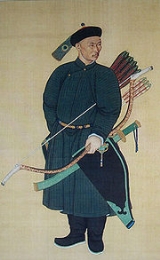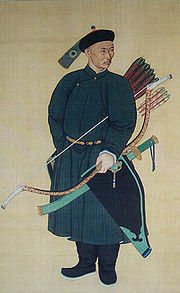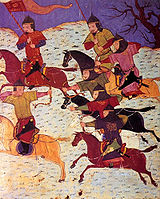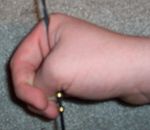
Mongol bow
Encyclopedia
The Mongol bow is a recurved composite
bow
renowned for its military effectiveness. The old Mongolian bows that were used during the times
of Genghis Khan were smaller than the modern weapons used at most Naadam
festivals today. Modern Mongolian bows are larger and have string bridges. The modern design is very similar to the Manchurian bows used by the Chinese military during the Qing Dynasty
. The Mongolian archery tradition may be continuous, but archery was officially outlawed in Mongolia after it was conquered by the Manchu dynasty.

Ancient and modern Mongol bows are part of the Asian composite bow
tradition. The core is wooden, with horn
on the belly (facing towards the archer) and sinew
on the back, bound together with animal glue
. As animal glue is dissolved by water, composite bows may be ruined by rain or excess humidity; a wrapper of (waterproof) birch bark may give limited protection from moisture and from mechanical damage. The bow is usually stored in a leather case for protection when not in use.
s is the presence of a "string run" (or "string bridge") - an attachment of horn, leather, or wood used to hold the string a little further apart from the bow's limbs at the base of the siyah. This attachment aids the archer by increasing the draw weight in the early stages of the draw, thus slightly increasing the total energy stored by the draw and available to the arrow. String bridges are not attested at the time of the Mongol empire
, appearing in Chinese art during the later Manchu Qing dynasty
. The armies of Genghis Khan
would have used the composite bow
s typical of their various nationalities at the time.
 An inscription on a stone stele was found near Nerchinsk in Siberia: "While Chinggis (Genghis) Khan was holding an assembly of Mongolian dignitaries, after his conquest of Sartaul (Khwarezm
An inscription on a stone stele was found near Nerchinsk in Siberia: "While Chinggis (Genghis) Khan was holding an assembly of Mongolian dignitaries, after his conquest of Sartaul (Khwarezm
), Yesüngge (the son of Chinggis Khan's brother) shot a target at 335 alds (536 m)."
In the historical novel "Khökh Sudar" Injinashi, the Mongolian philosopher, historian and writer, imagines the competition amongst all Mongolian men in about 1194-1195: five archers each hit the target three times from a distance of 500 bows (1 bow = at least 1 metre).
 The Mongolian draw, or thumb draw, uses only the thumb, the strongest single digit, to grasp the string. Around the back of the thumb, the index and/or middle fingers reinforce the grip. This is traditional across the Asian steppes, as well as in Korea, Japan, Tibet, China, Turkey, India and recent Persia. It was also used by Ishi
The Mongolian draw, or thumb draw, uses only the thumb, the strongest single digit, to grasp the string. Around the back of the thumb, the index and/or middle fingers reinforce the grip. This is traditional across the Asian steppes, as well as in Korea, Japan, Tibet, China, Turkey, India and recent Persia. It was also used by Ishi
, the last of the Yana, with his short bows.
It gives a narrower grip on the string, as only one digit is used, and this may help to avoid "string pinch" with shorter bows such as the composite bow
s normally used from horseback. Mongol archers would wear a metal thumb ring
to protect the thumb. It may also avoid a problem occasionally faced by archers using the Mediterranean release, when the three fingers do not release at exactly the same time and thus foul the draw. This release is normally used with the arrow on the right side of the bow for a right-handed archer, and on the left side of the bow for a left-handed archer.
Composite bow
A composite bow is a bow made from horn, wood, and sinew laminated together. The horn is on the belly, facing the archer, and sinew on the back of a wooden core. Sinew and horn will store more energy than wood for the same length of bow...
bow
Bow (weapon)
The bow and arrow is a projectile weapon system that predates recorded history and is common to most cultures.-Description:A bow is a flexible arc that shoots aerodynamic projectiles by means of elastic energy. Essentially, the bow is a form of spring powered by a string or cord...
renowned for its military effectiveness. The old Mongolian bows that were used during the times
Mongol Conquests
Mongol invasions progressed throughout the 13th century, resulting in the vast Mongol Empire which covered much of Asia and Eastern Europe by 1300....
of Genghis Khan were smaller than the modern weapons used at most Naadam
Naadam
Naadam is a traditional type of festival in Mongolia. The festival is also locally termed "eriin gurvan naadam" "the three games of men". The games are Mongolian wrestling, horse racing and archery and are held throughout the country during the midsummer holidays...
festivals today. Modern Mongolian bows are larger and have string bridges. The modern design is very similar to the Manchurian bows used by the Chinese military during the Qing Dynasty
Qing Dynasty
The Qing Dynasty was the last dynasty of China, ruling from 1644 to 1912 with a brief, abortive restoration in 1917. It was preceded by the Ming Dynasty and followed by the Republic of China....
. The Mongolian archery tradition may be continuous, but archery was officially outlawed in Mongolia after it was conquered by the Manchu dynasty.

Construction

Ancient and modern Mongol bows are part of the Asian composite bow
Composite bow
A composite bow is a bow made from horn, wood, and sinew laminated together. The horn is on the belly, facing the archer, and sinew on the back of a wooden core. Sinew and horn will store more energy than wood for the same length of bow...
tradition. The core is wooden, with horn
Horn (anatomy)
A horn is a pointed projection of the skin on the head of various animals, consisting of a covering of horn surrounding a core of living bone. True horns are found mainly among the ruminant artiodactyls, in the families Antilocapridae and Bovidae...
on the belly (facing towards the archer) and sinew
Tendon
A tendon is a tough band of fibrous connective tissue that usually connects muscle to bone and is capable of withstanding tension. Tendons are similar to ligaments and fasciae as they are all made of collagen except that ligaments join one bone to another bone, and fasciae connect muscles to other...
on the back, bound together with animal glue
Animal glue
An animal glue is an adhesive that is created by prolonged boiling of animal connective tissue.These protein colloid glues are formed through hydrolysis of the collagen from skins, bones, tendons, and other tissues, similar to gelatin. The word "collagen" itself derives from Greek κόλλα kolla, glue...
. As animal glue is dissolved by water, composite bows may be ruined by rain or excess humidity; a wrapper of (waterproof) birch bark may give limited protection from moisture and from mechanical damage. The bow is usually stored in a leather case for protection when not in use.
String bridge
The principal difference between the modern Mongol bow and other composite bowComposite bow
A composite bow is a bow made from horn, wood, and sinew laminated together. The horn is on the belly, facing the archer, and sinew on the back of a wooden core. Sinew and horn will store more energy than wood for the same length of bow...
s is the presence of a "string run" (or "string bridge") - an attachment of horn, leather, or wood used to hold the string a little further apart from the bow's limbs at the base of the siyah. This attachment aids the archer by increasing the draw weight in the early stages of the draw, thus slightly increasing the total energy stored by the draw and available to the arrow. String bridges are not attested at the time of the Mongol empire
Mongol Empire
The Mongol Empire , initially named as Greater Mongol State was a great empire during the 13th and 14th centuries...
, appearing in Chinese art during the later Manchu Qing dynasty
Qing Dynasty
The Qing Dynasty was the last dynasty of China, ruling from 1644 to 1912 with a brief, abortive restoration in 1917. It was preceded by the Ming Dynasty and followed by the Republic of China....
. The armies of Genghis Khan
Genghis Khan
Genghis Khan , born Temujin and occasionally known by his temple name Taizu , was the founder and Great Khan of the Mongol Empire, which became the largest contiguous empire in history after his death....
would have used the composite bow
Composite bow
A composite bow is a bow made from horn, wood, and sinew laminated together. The horn is on the belly, facing the archer, and sinew on the back of a wooden core. Sinew and horn will store more energy than wood for the same length of bow...
s typical of their various nationalities at the time.
Range

Khwarezm
Khwarezm, or Chorasmia, is a large oasis region on the Amu Darya river delta in western Central Asia, which borders to the north the Aral Sea, to the east the Kyzylkum desert, to the south the Karakum desert and to the west the Ustyurt Plateau...
), Yesüngge (the son of Chinggis Khan's brother) shot a target at 335 alds (536 m)."
In the historical novel "Khökh Sudar" Injinashi, the Mongolian philosopher, historian and writer, imagines the competition amongst all Mongolian men in about 1194-1195: five archers each hit the target three times from a distance of 500 bows (1 bow = at least 1 metre).
Mongolian draw and release

Ishi
Ishi was the last member of the Yahi, the last surviving group of the Yana people of the U.S. state of California. Ishi is believed to have been the last Native American in Northern California to have lived most of his life completely outside the European American culture...
, the last of the Yana, with his short bows.
It gives a narrower grip on the string, as only one digit is used, and this may help to avoid "string pinch" with shorter bows such as the composite bow
Composite bow
A composite bow is a bow made from horn, wood, and sinew laminated together. The horn is on the belly, facing the archer, and sinew on the back of a wooden core. Sinew and horn will store more energy than wood for the same length of bow...
s normally used from horseback. Mongol archers would wear a metal thumb ring
Thumb ring
A thumb ring is a piece of equipment designed to protect the thumb during archery. This is a ring of leather, stone, horn, wood, ivory, metal, ceramics, plastic, or glass or which fits over the end of the thumb, coming to rest at the outer edge of the outer joint...
to protect the thumb. It may also avoid a problem occasionally faced by archers using the Mediterranean release, when the three fingers do not release at exactly the same time and thus foul the draw. This release is normally used with the arrow on the right side of the bow for a right-handed archer, and on the left side of the bow for a left-handed archer.
See also
- Composite bowComposite bowA composite bow is a bow made from horn, wood, and sinew laminated together. The horn is on the belly, facing the archer, and sinew on the back of a wooden core. Sinew and horn will store more energy than wood for the same length of bow...
- Turkish bowTurkish bowThe Turkish bow is a recurved composite bow used in the Ottoman Empire.The construction was that of the classic Asiatic composite bow, with a wooden core , animal horn on the side facing the archer, and sinew on the back. Animal glue held it together...
- Korean bow
- Bow drawBow drawA bow draw is the method used to draw a bow. Currently, the most common method is the Mediterranean draw, long the usual method in European archery. Other methods include the pinch draw and the Mongolian draw.- Pinch draw or "primary release":...
- Bow stringBow stringA bow string joins the two ends of the bow stave and launches the arrow. Desirable properties include light weight, strength, resistance to abrasion, and resistance to water...
- Mounted archeryMounted archeryA horse archer, horsed archer, or mounted archer is a cavalryman armed with a bow, able to shoot while riding from horseback. Archery has occasionally been used from the backs of other riding animals...

